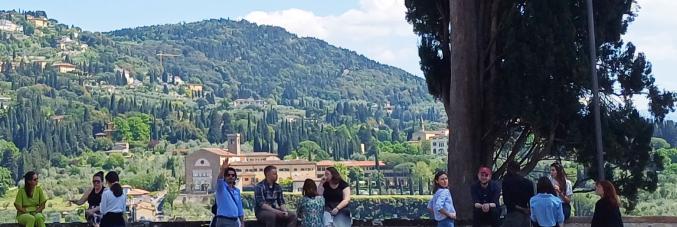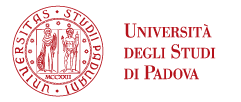
Bi-lateral Workshop | Research on the Move
Sala Bortolami, Palazzo Jonoch Gulinelli - via del Vescovado, 30, Padova
12.06.2025
June 12th, 2025, h. 11.00
Research on the Move
A Bi-lateral Workshop between the Migration and Mobility Working Group of the European University Institute, the MA Programme in Mobility Studies of the University of Padova and the PhD in Historical, Geographical and Anthropological Studies of the Universities of Padova and Venice Cà Foscari.
Programme:
h. 11.00: Introduction and Greetings (Paola Molino, Tania Rossetto, Giulia Albanese)
h. 11.30-12.00
Tymoteusz Skowronski: Citizens, Foreigners, Minorities: State Practices of Identification in Poland 1918-1939
Discussants: Niccoló Pianciola, Hasan Sezer
The aim of this paper is to discuss identification apparatuses (Caplan & Torpey 2001) used by the interwar Polish state to police mobilities throughout the 1920s. I approach mobilities control from the perspective of local administrative practices, thereby encompassing the agency of individuals vis-à-vis the state. By adopting a regional focus on the disputed area of Vilnius/Wilno, I intend to diverge from linear narratives about state-building and address migration control in a context of post-imperial violence and collapse of state-power (Balkelis& Griffante 2023). Facing a massive influx of refugees from Soviet Russia, as well as instable border-making (Balkelis 2018), local authorities relied on administrative legacies of the Russian empire and the German Ober-Ost when registering residencies and controlling identities (Liulevicius 2001, Kasmach 2023). What is more, after passing from hands to hands during the 1919-1920 Polish-Soviet and Polish-Lithuanian wars, the Vilnius/Wilno region was first incorporated into the puppet Republic of Middle Lithuania, before its official annexation to Poland as the “Wilno Land” in 1922. The voivodeship of Wilno was created in 1926, ending the region’s exceptionality and incorporating it into the administrative apparatus of the state. Instead of analyzing this as a process of gradual extension of Polish legal authority over Wilno/Vilnius and of uniformization of state-practice across Poland, I approach this region as a laboratory for distinguishing ‘unwanted’ populations from desired citizens. Thus, regional dynamics help understand the stabilization of Polish apparatuses of mobility control that were established at the end of the 1920s.
h. 12.00-12.30
Maria Pantazi, The city of extremes: social networks, social distance, and survival in Thessaloniki during Jewish deportations
Discussants: Giulia Albanese, Midya Navidi
Thessaloniki’s extermination rate during the Holocaust reached 96% of it’s total pre-WWII Jewish population. Up until then, it had a well-established Sephardic community of approximately 50.000 individuals that made up the ¼ of the city’s total population. The almost total extermination rate has been explained in terms of the severity of the Nazi anti-Jewish measures in 1943, combined with the indifferent – at best case – interpersonal relationships between Jews and non-Jews, as shaped by the Hellenization policies of the Greek State during the interwar period. By focusing on survival rather than extermination, I seek for the shared social spaces that allowed the formation of bonds of trust between Jews and non-Jews that the former could mobilize during the extremes of the persecution. For this I use videotaped oral testimonies from the Visual History Archive of the University of Southern California. The large nuber of interviewees from Thessaloniki (more than 100) and the form of life narratives allows me to trace the interpersonal bonds that they consider crucial for their evasion of deportation to deathcamps. The detailed information on their socio-economic backgrounds (neighborhood, level and type of education, profession, languages, age, gender, and family composition) allows me to examine in depth the conditions that made the aforementioned relationships materialize.
For this presentation I am focusing on a group of Italian-affiliated Salonican Jews that received help from the Italian Consulate of Thessaloniki. Combining oral testimonies with archival material from the Italian and the Greek Ministries of Foreign Affairs I explore the ways individuals perceived and made use of Italian affiliation in terms of origins, passport, education, and migration during the interwar and wartime period. By shedding light on the ways individuals interacted with national authorities, and also on the conditions of the provision of help during the extremes of the persecution, I wish to challenge the notion of rescue as an one-off, top-down event and highlight the spectrum and the limits of agency of the persecuted before and during the moment of the persecution.
Lunch Break
h. 14.00-14.30
Emma dal Mas, Managing displaced persons: the case of post 1945 Austria
Discussant: Elena Maria Rizzi, Chukwudi Matthew Anuforo
Austria after the end of World War II was the first country of arrival for different groups of Displaced Persons. These people were on the move for multiple reasons. My research focuses on the group of people of German origins that was expelled in different waves from Central Eastern Europe and reached Austria as forced migrants. While almost 300.000 of them remained in Austria, their story remains largely untold. Their presence in Austria caused by forced mobility led to a very specific situation in terms of organization, support, and management policies. Being expelled from their countries under the accusation of collaborationism with defeated Nazi Germany, the German refugees were not officially recognized as Displaced Persons under the aegis of the United Nations. Because of that, the network of associations and organizations that supported them while in Austria was made of private and religious organizations, that cooperated with the Austrian state. Forced mobility after World War II impacted Austrian society in different ways. My presentation will then address two main questions: which agencies managed and supported the German refugees in Austria? And which premises and connections were established among these agencies? I will present my hypothesis and discuss early archival findings from this perspective.
h. 14.30-15.00
Aleksander Lemeshinski, Mobilizing Architecture: West German Exhibitions in the Postwar Transnational Exchange
Discussants: Ginevra Villani, Alena Lesniak
This presentation explores the (im)mobility of architecture, focusing on how architectural knowledge and meaning circulate through media beyond the built environment. Architectural culture—disseminated via drawings, photographs, blueprints, sketches, digital media, models, and more—forms intricate transnational networks of exchange and dialogue, but also of hierarchy and empowerment. Among these media, the exhibition stands out as a key vehicle for architectural mobility. Architectural exhibitions convey ideas, values, and cultural narratives across spatial and political boundaries, even in the absence of actual structures. Similarly, books, journals, conferences, and professional travel contribute to a broader sociological understanding of architecture as a cultural practice shaped by circulation. Exhibitions, especially those that travel internationally, render architecture both legible and mobile. By shifting architectural meaning from a fixed site to various places, they challenge the inherent immobility of buildings and recontextualize architecture within diverse geopolitical settings. This presentation examines a compelling yet underexplored example from postwar West Germany: an architectural exhibition commissioned by the Foreign Office in 1951 and launched in 1953, which toured over twenty countries within 4 years. Comprising roughly 150 photographs, selected publications, plaques, and occasional documentary films, the exhibition played a crucial role in shaping international perceptions of West German architecture and culture during the Cold War. By abstracting architecture from its physical form, it functioned as a tool of diplomacy, aiding West Germany’s efforts to reframe its global image in the aftermath of the Nazi regime. This case study offers an insight into the transnational mobility of architectural ideas and imageries amid diverse political soils. It speaks to the workshop’s focus on the movement of ideas, objects, and cultural practices and underscores the significance of exhibitions as agents in the global circulation of architectural discourse.
h. 15.00-15.30
Eike Klages, British Refugee Admission Strategies 1972-1992: The path to Europe as a venue to fill the gap between goals and outcomes
Discussants: Mikhail Vsemirnov, Thays De Souza Ellero
Contrary to the narrative pushed by the “Vote Leave” campaign before the British EU membership referendum in 2016, European co-operation and integration in migration and asylum policy were not a constraint of the United Kingdom’s sovereignty but served as platforms for British decision-makers to expand on their restrictionist goals. My research project places the engagement of British officials with European integration in these fields within the context of British refugee admissions between 1972 and the mid-1980s. At its core lie three case studies focussing on different groups of refugees: (1) the “Ugandan Asians” who were expelled in 1972, (2) the Vietnamese “boat people” whose numbers peaked in 1979, and (3) Tamil refugees from the Sri Lankan civil war during the mid-1980s. These case studies not only highlight the global (post-)colonial entanglements of the United Kingdom but are also an important part of the history of racism in Britain due to the racialisation of the groups fleeing their home. In the investigation of my case studies, I utilise the interdisciplinary nature of migration studies to employ adapted versions of political science concepts such as James Hollifield’s gap-hypothesis and Virginie Guirau-don’s venue-shopping framework as a point of departure to examine the agency of elected decision-makers and the notion of government sovereignty against the backdrop of do-mestic interests influencing decisions as well as the attempts to use different political arenas to circumvent these influences. Starting from the British national context, my re-search project challenges the feelgood-story of freedom of movement in Europe by high-lighting the measures taken to deny this freedom to those moving to Europe and framing the European venue as a further step in the establishment of restrictionist regulations based on national traditions.
Conclusions: Lucio Biasiori and Elena Canadelli





